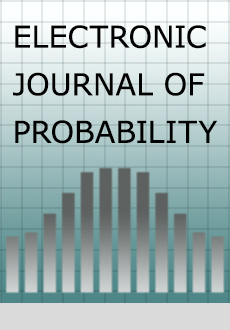Abstract
Here we will use results of Cox, Durrett, and Perkins for voter model perturbations to study spatial evolutionary games on $\mathbb{Z}^d$, $d\ge 3$ when the interaction kernel is finite range, symmetric, and has covariance matrix $\sigma^2 I$. The games we consider have payoff matrices of the form $1+ wG$ where $1$ is matrix of all 1's and $w$ is small and positive. Since our population size $N=\infty$, we call our selection small rather than weak which usually means $w =O(1/N)$. The key to studying these games is the fact that when the dynamics are suitably rescaled in space and time they convergence to solutions of a reaction diffusion equation (RDE). Inspired by work of Ohtsuki and Nowak and Tarnita et al we show that the reaction term is the replicator equation for a modified game matrix and the modifications of the game matrix depend on the interaction kernel only through the values of two or three simple probabilities for an associated coalescing random walk. Two strategy games lead to an RDE with a cubic nonlinearity, so we can describe the phase diagram completely. Three strategy games lead to a pair of coupled RDE, but using an idea from our earlier work, we are able to show that if there is a repelling function for the replicator equation for the modified game, then there is coexistence in the spatial game when selection is small. This enables us to prove coexistence in the spatial model in a wide variety of examples where the replicator equation of the odified game has an attracting equilibrium with all components positive. Using this result we are able to analyze the behavior of four evolutionary games that have recently been used in cancer modeling.
Citation
Rick Durrett. "Spatial evolutionary games with small selection coefficients." Electron. J. Probab. 19 1 - 64, 2014. https://doi.org/10.1214/EJP.v19-3621





